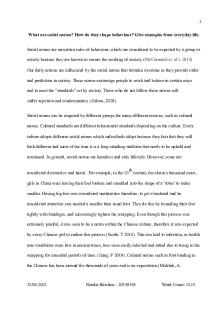Social deviance - essay PDF

| Title | Social deviance - essay |
|---|---|
| Author | Alexandria Washington |
| Course | Social Problems |
| Institution | Grand Canyon University |
| Pages | 4 |
| File Size | 75 KB |
| File Type | |
| Total Downloads | 105 |
| Total Views | 157 |
Summary
essay...
Description
Alexandria Washington SOC-220 03-28-2021 Professor Wilson
Social Deviance Social deviance is defined as “characteristics and behaviors that violate important group norms as a consequence reacted to with social disapproval (Sullivan,2016).” Deviant behavior lies under two different categories. One being informal and one being formal. For example, informal deviance is when you may be doing something to disturb someone else, but it is not considered breaking a low. Formal deviance is when you are involved in criminal behavior and commit a crime that affects yourself and possibly others around you. Social abnormalities affect us heavily. One social issue that is prevalent in America today is sex trafficking or illegal exploitation. Social deviance is disturbing the norm and causing a social issue in result of it. Social deviance stems from what a person already has seen or already is engaging in as an activity. This is because of the "Labeling Theory”. The Labeling theory is the point at which somebody is trapped in an act that is against accepted practices and is hence named (Sullivan,2016). For example, minorities today are named as lawbreakers or attackers after committing a crime. Being labeled a lawbreaker or an attacker makes them feel that they truly are. The social abnormality for this situation being sex trafficking, can be seen on both micro and macro levels. Illegal exploitation is taking somebody without their consent and constrained into things like work or prostitution. Illegal exploitation on the macro level can be seen as being
needy. Eighty percent of individuals dealt are women and the other percentage to make up that are underage. Many individuals who are underage are trafficking because it stems from something else. For example, it may stem from lack of parenting growing up, lack of education, and lack of self-love so they look elsewhere and are extremely vulnerable in the midst of it (Scullion,2015). As referenced above, vulnerability would be considered under a micro level. Another factor that falls under the micro level would be one's confidence which brings back the labeling theory. In the event that somebody causes another person to feel that they are not adequate, they are not keen of quite enough, they won't become anything incredible throughout everyday life. When an underage person gets caught up in the life of trafficking it simply is because they were vulnerable, the attacker made them feel worthy and valuable and it boosted their self-esteem to continue on with the wrong crowds. The wrong crowds unfortunately, will lead to a worse ending for many. Preventing illegal exploitation can be very hard. Many attempts are made daily o try and prevent this, yet there are also many failed attempts that isn’t necessarily announced publicly. However, we actually see illegal exploitation as a significant social issue. Today, the solution to illegal exploitation is the deterrence theory. It is to prevent the offenders from committing these same crimes over and over again and keeping those tempted to not able to commit these crimes. “When one is caught committing a heinous crime, if it is legal in their state, they may be able to receive the death penalty (Dilulio,1959).” The death penalty is a great tactic to prevent and stop others from wanting to commit the same crime. Though another solution within the theory of deterrence can be therapy. Therapy may be a good solution as it will enforce these acts to teach about the consequences one will endure by committing the crimes as such. If both of these solutions were to work the statistics for this social problem would decrease significantly.
References Dilulio, J., Jr. (1959). Deterrence Theory. Retrieved October 18, 2020, from https://marisluste.files.wordpress.com/2010/11/deterrence-theory.pdf
Scullion, D. (2015). Assessing the extent of human trafficking: inherent difficulties and gradual progress. Social Inclusion, 1, 22. https://doi-org.lopes.idm.oclc.org/10.17645/si.v3i1.176
Sullivan, T., J. (2016) Introduction to Social Problems, Tenth Edition. Pearson Education.
Retrieved from: https://viewer.gcu.edu/vEbNCw...
Similar Free PDFs

Social deviance - essay
- 4 Pages

Social Deviance
- 2 Pages

Deviance essay
- 5 Pages

Deviance
- 5 Pages

Social Deviance Exam 1 Study Guide
- 12 Pages

Deviance
- 5 Pages

Deviance chapter
- 32 Pages

Social Norms Essay
- 8 Pages

Social Problem Final Essay
- 4 Pages

Social groupthink essay
- 8 Pages

Essay social work methods
- 18 Pages
Popular Institutions
- Tinajero National High School - Annex
- Politeknik Caltex Riau
- Yokohama City University
- SGT University
- University of Al-Qadisiyah
- Divine Word College of Vigan
- Techniek College Rotterdam
- Universidade de Santiago
- Universiti Teknologi MARA Cawangan Johor Kampus Pasir Gudang
- Poltekkes Kemenkes Yogyakarta
- Baguio City National High School
- Colegio san marcos
- preparatoria uno
- Centro de Bachillerato Tecnológico Industrial y de Servicios No. 107
- Dalian Maritime University
- Quang Trung Secondary School
- Colegio Tecnológico en Informática
- Corporación Regional de Educación Superior
- Grupo CEDVA
- Dar Al Uloom University
- Centro de Estudios Preuniversitarios de la Universidad Nacional de Ingeniería
- 上智大学
- Aakash International School, Nuna Majara
- San Felipe Neri Catholic School
- Kang Chiao International School - New Taipei City
- Misamis Occidental National High School
- Institución Educativa Escuela Normal Juan Ladrilleros
- Kolehiyo ng Pantukan
- Batanes State College
- Instituto Continental
- Sekolah Menengah Kejuruan Kesehatan Kaltara (Tarakan)
- Colegio de La Inmaculada Concepcion - Cebu




